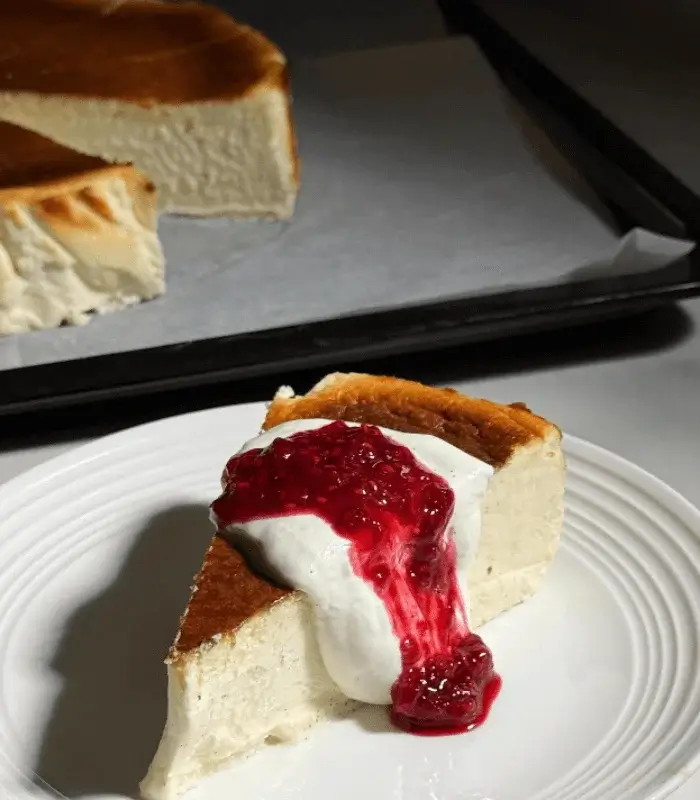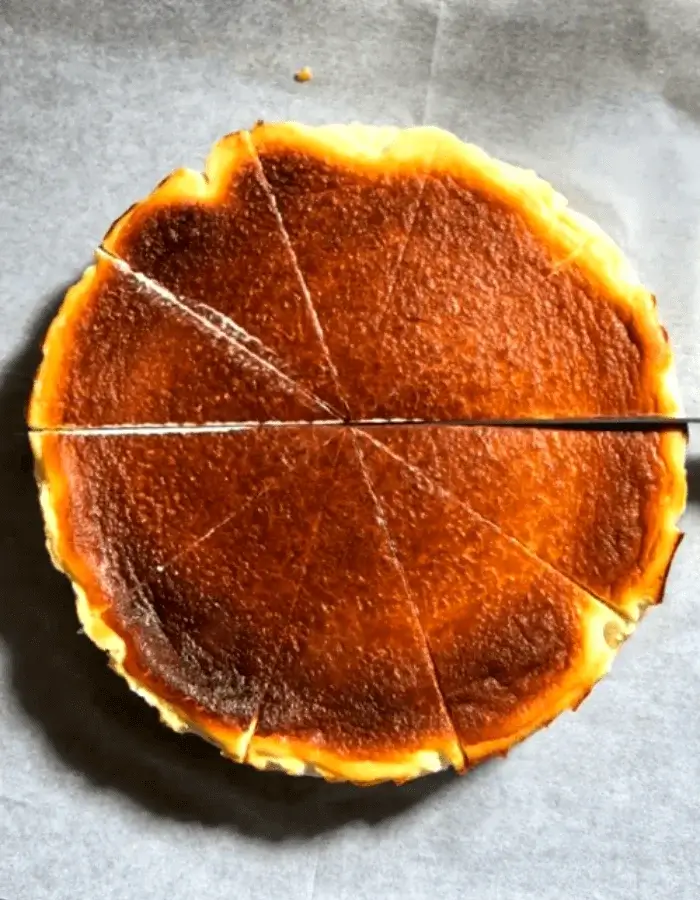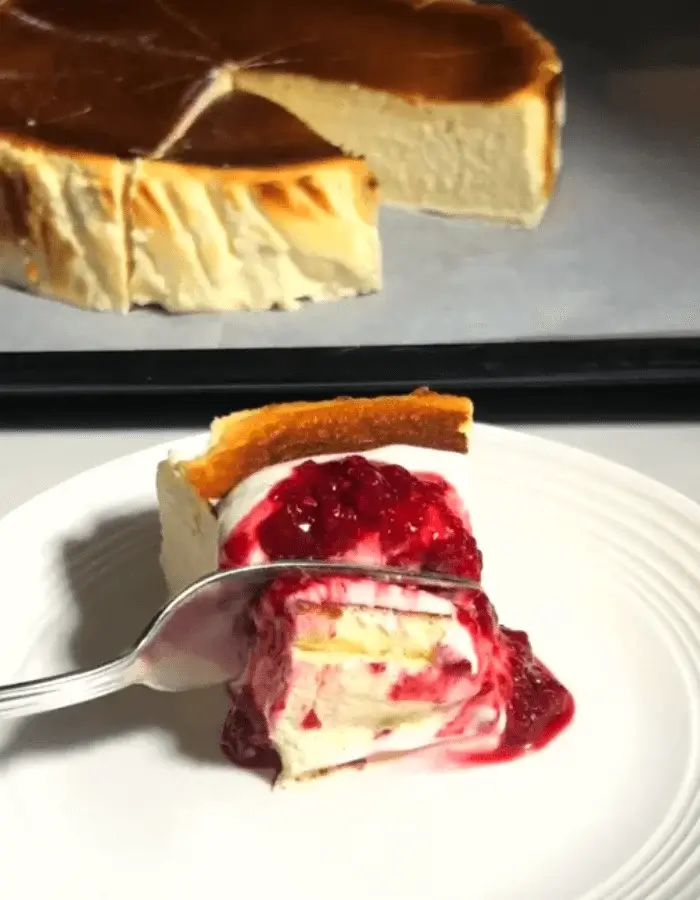Gluten Free Basque Cheesecake
We may earn a commission from recommended products, at no extra cost to you. See Disclosure.
- 9.5-inch/24 cm springform pan
- Fine-mesh sieve
INGREDIENTS
- 2.2 pounds/1 kilogram cream cheese
- 1½ cups/300 grams sugar
- 7 large eggs
- 1⅔ cups/400 milliliters heavy cream
- ⅓ cup/40 grams cornstarch
- 1 tablespoon vanilla bean paste or seeds from 1 vanilla bean
INSTRUCTIONS
- Preheat the oven to 430°F (220°C) on convection. Line a 9.5-inch/24 cm round springform pan with parchment paper, letting the paper rise at least 2 inches above the rim to accommodate the cake’s rise and fall.
- In a stand mixer fitted with the paddle attachment, beat the cream cheese and sugar on medium speed until smooth and lump-free, about 2 to 3 minutes. Scrape down the sides of the bowl once or twice to ensure even mixing.
- Add the eggs one at a time, beating well between each addition. The batter should look silky and uniform. Pour in the heavy cream and beat just until fully incorporated. Scrape the bowl again. Sift in the flour or cornstarch and gently fold it into the batter using a spatula, stirring just until blended.
- Pour the batter into the prepared pan and tap gently on the counter to remove air bubbles. Bake for 30 to 35 minutes, until the top is deeply bronzed and the center still jiggles visibly.
- Let the cheesecake cool completely at room temperature, then refrigerate overnight until fully set.
- To serve, gently lift it out of the pan using the parchment paper.

FAQ
Can I make this gluten free Basque cheesecake without cornstarch?
You can omit the cornstarch entirely, especially since it is used in small amounts mainly for structure. The eggs and cream cheese provide enough stability for the cake to set properly. The result may be slightly softer in the center, but the texture will still be rich and custardy. If you want to keep a similar structure without using cornstarch, you can substitute with potato starch or tapioca starch, which are also naturally gluten free.

What type of cream cheese works best for this cake?
Full-fat cream cheese with 30% fat or more gives the best texture and flavor. It should be at room temperature before mixing to ensure a smooth, lump-free batter. Avoid low-fat or whipped cream cheese, as they contain stabilizers and extra moisture, which can affect the final consistency. Most plain cream cheeses are gluten free, but always read the label to confirm there are no hidden gluten-containing additives. Using a high-quality, block-style cream cheese will give the most authentic, creamy result and help the cheesecake hold its shape after baking and cooling.
How can I prevent the cheesecake from cracking?
Cracks in this cheesecake are rare since the baking process intentionally creates a dark, blistered top and a jiggly center. However, to minimize cracking or collapsing, avoid overbaking and ensure the oven is properly preheated to a high temperature. Use room temperature ingredients for a smoother batter, and don’t overmix once the eggs are added, as that can introduce too much air. Also, avoid opening the oven door too often. Let the cake cool slowly at room temperature before refrigerating overnight. This resting time allows the structure to firm up and reduces the chance of cracks forming.
Do I have to use a springform pan?
While not strictly required, a springform pan is highly recommended for gluten free Basque cheesecake. The high sides and removable ring make it easier to release the delicate cake without damaging its soft center or caramelized top. Choose a 9.5-inch/24 cm springform pan and line it generously with parchment paper that rises well above the pan edges. If using a standard round cake pan, make sure it’s deep enough and fully lined so you can lift the cake out safely. Allowing the cheesecake to chill thoroughly also helps it firm up before unmolding.

What toppings go well with gluten free Basque cheesecake?
Fresh berries, macerated fruit, or a drizzle of berry compote add a refreshing contrast to the dense, creamy texture. Lightly whipped cream, lemon curd, or a spoonful of cherry preserves can also complement the cheesecake without overpowering it. For something more indulgent, try salted caramel sauce or shaved dark chocolate.
Is it necessary to use a convection oven?
Using a convection oven is not strictly necessary for gluten free Basque cheesecake, but it does help achieve a more evenly browned and deeply caramelized top. Convection ovens circulate hot air, which promotes more consistent browning and can slightly shorten baking time. If using a conventional (non-convection) oven, increase the temperature by about 20°F (10°C) and bake a few minutes longer if needed. Watch the top of the cake—once it’s deeply golden and the center jiggles when gently shaken, it’s ready. Either method works, as long as the high temperature and visual cues are followed.
Can I freeze leftover gluten free Basque cheesecake?
Yes, this cheesecake freezes well. Once fully chilled and set in the refrigerator overnight, cut it into slices or freeze it whole. Wrap each portion tightly in plastic wrap and then in foil, or store in an airtight freezer-safe container. Label with the date and freeze for up to one month for best quality. Thaw in the refrigerator overnight before serving. The texture will remain creamy, although slightly denser after freezing. Avoid refreezing thawed portions, and never freeze the cake before it has set fully in the fridge to prevent texture loss.
Why does my cheesecake sink in the center?
A sunken center is normal for gluten free Basque cheesecake and is actually a hallmark of the style. The cake rises rapidly at high temperature, then deflates slightly as it cools, forming a rustic, cratered top. This isn’t a flaw—it reflects the contrast between the set edges and the soft, custard-like center. However, excessive sinking may result from underbaking or using too many air bubbles in the batter. Make sure to tap the pan on the counter before baking to release trapped air. Chilling the cheesecake thoroughly also helps it hold its shape after deflating.

